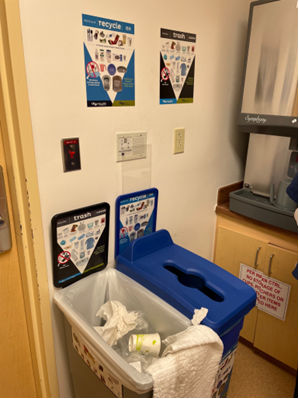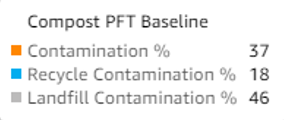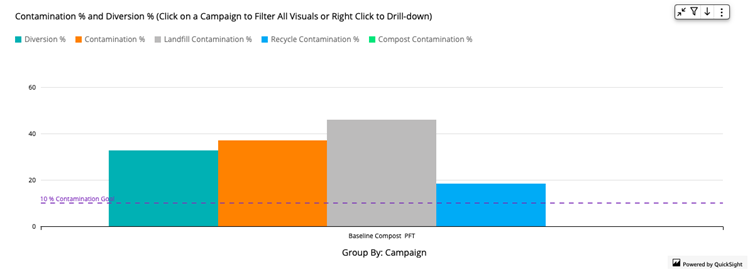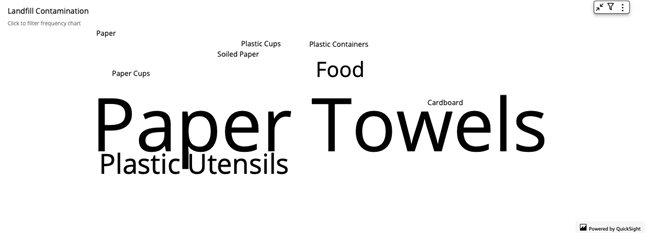Excessive waste contamination and improper sorting has caused the UCSF Medical Centers to be fined around $7,000 a month for exceeding the Recology maximum allowable contamination of waste, being 25% contamination of landfill, 10% recycling, and 5% compost. Specifically, the contamination of the recycling stream is the main cause of these fines. Currently there are only compost bins in the public bathrooms on all floors of the Parnassus Medical Center. Compost can also be left on patient trays on the floors where patient meals are served (floors 6-15 of Moffitt and Long buildings, with the exception of the 11 AHU unit). The trays are held in patient tray carts, which are located next to the pantries, and any waste left on them is sorted by kitchen staff. There is a dirty cart available at all times of day. Multiple staff working at Parnassus have reached out to the Office of Sustainability asking where they can leave their food scraps, unaware of the patient tray compost program. This has led to contamination of landfill and recycling bins in the break rooms with compostable materials.
Purpose
The purpose of the compost on patient food tray pilot program is to reduce the food contamination of landfill and recycling bins in the break rooms on the floors where the patient tray compost program is available, and to increase the amount of compostable materials recovered. Specifically, the purpose is to reduce the contamination of the recycling to below the 10% threshold standard of Recology, and of the landfill to the 25% threshold standard of Recology.
Strategy Selected
To address the compost contamination issue, the strategy proposed is to implement new signage in the break rooms, in the pantry, on the walls by the patient tray carts, on the patient tray carts, and give extra copies to the unit leadership to distribute. Additionally, unit staff will be trained about the new compost program.
- Creating new compost signage to state that compost can be left on patient trays with corresponding images will inform staff of where compost can be left.
- By adding signs to the break rooms, in the pantry, on the walls by the patient tray carts, and on the patient tray carts, information on the compost program will be available in the places where unit staff are most likely to think about the program.
- Giving extra copies to unit leadership to distribute will help signage end up where it is most likely to be seen based on the workflow of the floor.
- Training unit staff to inform them of the changes will ensure everyone is aware of the new program.
Constraints
- New staff or staff that miss training may not be aware of the compost program.
- Patient tray carts get swapped out, it may be hard to ensure there is always signage on all of them.
 Example of new compost signage.
Example of new compost signage.
 Patient food tray cart.
Patient food tray cart.
 A pantry waste station.
A pantry waste station.
Objective of Pilot Program
To determine if new compost signage promoting the patient tray composting program helps to reduce the compost contamination of landfill and recycling bins in the break rooms where patient tray composting is available.
Implementation Process
2 units:
- 7 Ortho/Spine Moffitt breakroom has one landfill bin.
- 10 CVT Long breakroom has one landfill bin and one recycling bin.
- Reach out to heads of units/custodial team to inform them of the new program.
- Ask unit leadership if they are willing to be a sample unit.
- Ask both unit leadership and custodial teams when the best time to perform audits is.
- Perform 6 control waste audits of break room bins using the Zabble app. Waste audits entail doing a visual assessment of the surface level of the bin, marking the fullness percentage, the percentage of contamination, and which contamination items are present.
- Timeline: 2 weeks, 3 times a week, with 2 audits to be done with a trash grabber.
12/1/22 with a trash grabber
12/2/22 with a trash grabber
Assess data to see if project is worth implementing. If so:
- Implement new compost signage to break rooms, in the pantry, on the walls by the patient tray carts, on the patient tray carts, and give extra copies to the unit leadership to distribute.
- Train unit staff about the new program.
- Complete 6 endline waste audits of break room bins.
- Timeline: 2 weeks, 3 times a week, with 2 audits to be done with a trash grabber.
Metrics of Success
Audits done at varying times after completion of the pilot program will help determine if there was a spike in diversion after the program was implemented, and to see if the increase in diversion is retained. If contamination levels on average amongst the floors go down, and the amount of compost recovered goes up, the pilot program will be considered successful. Details of contamination diversion based on audits are visible on the Zabble dashboard. This includes the average contamination percentage and diversion rate amongst all the floors.
Next Steps
If the pilot program is successful, we would also consider expanding the compost on patient food tray program the rest of the Parnassus Medical Center (floors 6-15), to the Mount Zion Medical Center (floors 4 and 5), and to the Mission Bay Medical Center (A3-6 and C4-6). If the pilot program doesn’t prove to be successful, further pilot programs would need to be established to test other contamination reduction strategies.
Projects would include testing out adding compost bins to floors with many sinks. If it is found that there is a significant amount of paper towel contamination in landfill and recycling bins on floors that have many sinks, adding compost bins next to sinks should be considered.
Results
After assessing the control data, the contamination of the bins in the breakrooms did not have a significant amount of food waste being disposed of. The baseline audits showed a landfill contamination of 46%, a recycling contamination of 18%, and an overall contamination of 37%. Of the 12 total audits (6 each in 2 units), there were only 3 instances of minimal food contamination. The primary contaminant of the break room bins was instead paper towels, indicating that compost bins would be more effective at reducing waste stream contamination. Instead of creating a campaign to tell staff that compost can be left on patient trays, this information will be worked into the regular staff waste sustainability trainings.
 Baseline audits results table.
Baseline audits results table.
 Results of the baseline audits.
Results of the baseline audits.
 Word cloud showing landfill contaminants proportional to number of instances found.
Word cloud showing landfill contaminants proportional to number of instances found.
 Word cloud showing recycling contaminants proportional to number of instances found.
Word cloud showing recycling contaminants proportional to number of instances found.